
Fort Leavenworth is a United States Army installation located in Leavenworth County, Kansas, in the city of Leavenworth, roughly 20 miles northwest of Kansas City. Built in 1827, it is the second oldest active United States Army post west of Washington, D.C., and the oldest permanent settlement in Kansas. Fort Leavenworth has been historically known as the "Intellectual Center of the Army."

Bent's Old Fort is an 1833 fort located in Otero County in southeastern Colorado, United States. A company owned by Charles Bent and William Bent and Ceran St. Vrain built the fort to trade with Southern Cheyenne and Arapaho Plains Indians and trappers for buffalo robes. For much of its 16-year history, the fort was the only major white American permanent settlement on the Santa Fe Trail between Missouri and the Mexican settlements. It was destroyed in 1849.

Charles A. Lindbergh State Park is a 569-acre (2.3 km2) Minnesota state park on the outskirts of Little Falls. The park was once the farm of Congressman Charles August Lindbergh and his son Charles Lindbergh, the famous aviator. Their restored 1906 house and two other farm buildings are within the park boundaries. The house, a National Historic Landmark, and an adjacent museum are operated by the Minnesota Historical Society, known as the Charles Lindbergh House and Museum. Three buildings and three structures built by the Works Progress Administration in the 1930s were named to the National Register of Historic Places. These buildings include a picnic shelter and a water tower, built in the Rustic Style from local stone and logs, and have remained relatively unchanged since construction. Although the property includes shoreline on the Mississippi River, the Lindbergh family requested that the park not include intensive use areas for swimming or camping, so development was kept to a minimum.
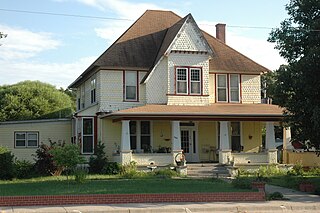
Charles W. Van De Mark House is a Queen Anne style historic building located in Clyde, Kansas, which is listed on the National Register of Historic Places. It was listed in 1985. It was deemed notable " local architectural significance as one of the most elaborate and best preserved of the late nineteenth-century houses of Clyde."
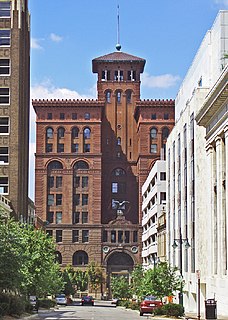
The New York Life Building is a 12-story, 54.86 m (180.0 ft) high-rise in the Library District of downtown Kansas City, Missouri. The brick and brownstone tower, which was completed in 1890, generally is regarded as Kansas City's first skyscraper and was the first building in the city equipped with elevators. It was commissioned by the New York Life Insurance Company, which also used the same design for the Omaha National Bank Building in Omaha that was completed in 1889. Several buildings around the world share its name. A centerpiece of the Library District and Baltimore Avenue Historic District, the building is located amid historic structures such as the Kansas City Club and the Central Library.

Mount Clare, also known as Mount Clare Mansion and generally known today as the Mount Clare Museum House, is the oldest Colonial-era structure in the City of Baltimore, Maryland, U.S.A. The Georgian style of architecture plantation house exhibits a somewhat altered five-part plan. It was built on a Carroll family plantation beginning in 1763 by barrister Charles Carroll the Barrister, (1723–1783), a descendant of the last Gaelic Lords of Éile in Ireland and a distant relative of the much better-known Charles Carroll of Carrollton, (1737–1832), longest living signer of the Declaration of Independence and the richest man in America in his later years, also the layer of the First Stone of the new Baltimore and Ohio Railroad, just a short distance away in 1828.

This is a list of the National Register of Historic Places listings in Leavenworth County, Kansas.

The John Brown Museum, also known as the John Brown Museum State Historic Site and John Brown Cabin, is located in Osawatomie, Kansas. The site is operated by the Kansas Historical Society, and includes the log cabin of Reverend Samuel Adair and his wife, Florella, who was the half-sister of the abolitionist John Brown. Brown lived in the cabin during the twenty months he spent in Kansas and conducted many of his abolitionist activities from there. The museum's displays tell the story of John Brown, the Adairs and local abolitionists, and include the original cabin, Adair family furnishings and belongings, and Civil War artifacts.

There are nine historic districts in Meridian, Mississippi. Each of these districts is listed on the National Register of Historic Places. One district, Meridian Downtown Historic District, is a combination of two older districts, Meridian Urban Center Historic District and Union Station Historic District. Many architectural styles are present in the districts, most from the late 19th century and early 20th century, including Queen Anne, Colonial Revival, Italianate, Art Deco, Late Victorian, and Bungalow.

The Peoples Gas Building at 122 South Michigan Avenue on the corner of Adams Street in the Loop community area of Chicago, Illinois.

William Pratt Feth (1866–1959) and Myron K. Feth were architects in Kansas. A number of their works are listed on the U.S. National Register of Historic Places.
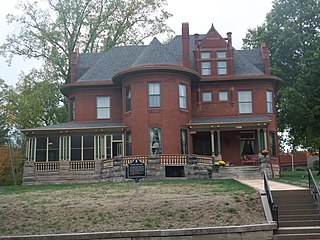
The Nathaniel H. Burt House is a historic house located at 400 Fifth Avenue in Leavenworth, Kansas. It was listed on the National Register of Historic Places on October 27, 1987.

The Reamer Barn is a historic barn near the village of Oberlin in the northeastern part of the U.S. state of Ohio. Constructed at the end of the nineteenth century, it was built to house a gentleman farmer's cattle herd, and it has been named a historic site because of its distinctive architecture.
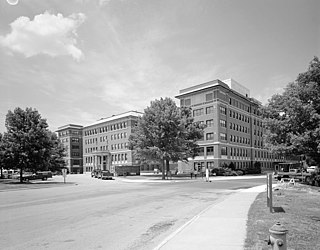
The Western Branch of the National Home for Disabled Soldiers was established in 1885 in Leavenworth, Kansas to house aging veterans of the American Civil War. The 214-acre (87 ha) campus is near Fort Leavenworth, and is directly adjacent to Leavenworth National Cemetery, south of Leavenworth town. The home features about 82 contributing building resources, constructed between the 1880s and the 1940s. It is now part of the Department of Veterans Affairs Eisenhower Medical Center.
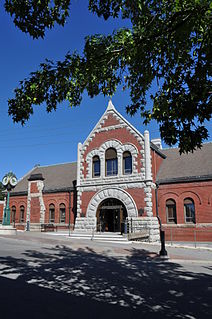
Leavenworth Riverfront Community Center was a former Union Pacific railroad station located in Leavenworth, Kansas, United States. It is also known as the Old Union Depot when it was listed on the National Register of Historic Places (NRHP) in 1987. It is currently known as the Leavenworth Riverfront Community Center.

The Ness County Bank, located at Main St. and Pennsylvania Ave. in Ness City, Kansas, was built during 1888–1890. It was listed on the National Register of Historic Places in 1972.
The I.P. Campbell Building, located at 116 W. Main St. in Harper, Kansas, was built in 1881. It was listed on the National Register of Historic Places in 2006.
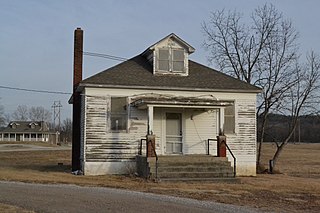
Hund School is a historic one-room schoolhouse northwest of the city of Leavenworth in Leavenworth County, Kansas. A wood bungalow, it was built in 1939 on land donated to the local school district by Wendelin and Josephine Hund in 1882. It replaced a school building that was destroyed in a fire.

Hollywood Theater is a historic Art Deco theater building in Leavenworth, Kansas. Designed by Robert Boller of the Boller Brothers, it is typical of theaters that were designed to be showcases in the 1920s and 1930s. It was built about 1937 or 1938 and opened on July 23, 1938. The historic building was listed on the National Register of Historic Places in 1990.
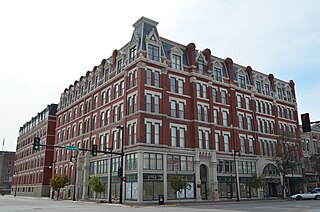
Carey House, also known as the Eaton Hotel, is a historic building completed in 1887 in Wichita, Kansas. It was built by businessman and mayor John B. Carey and has a tower at its northeast corner. It is listed on the National Register of Historic Places.




















